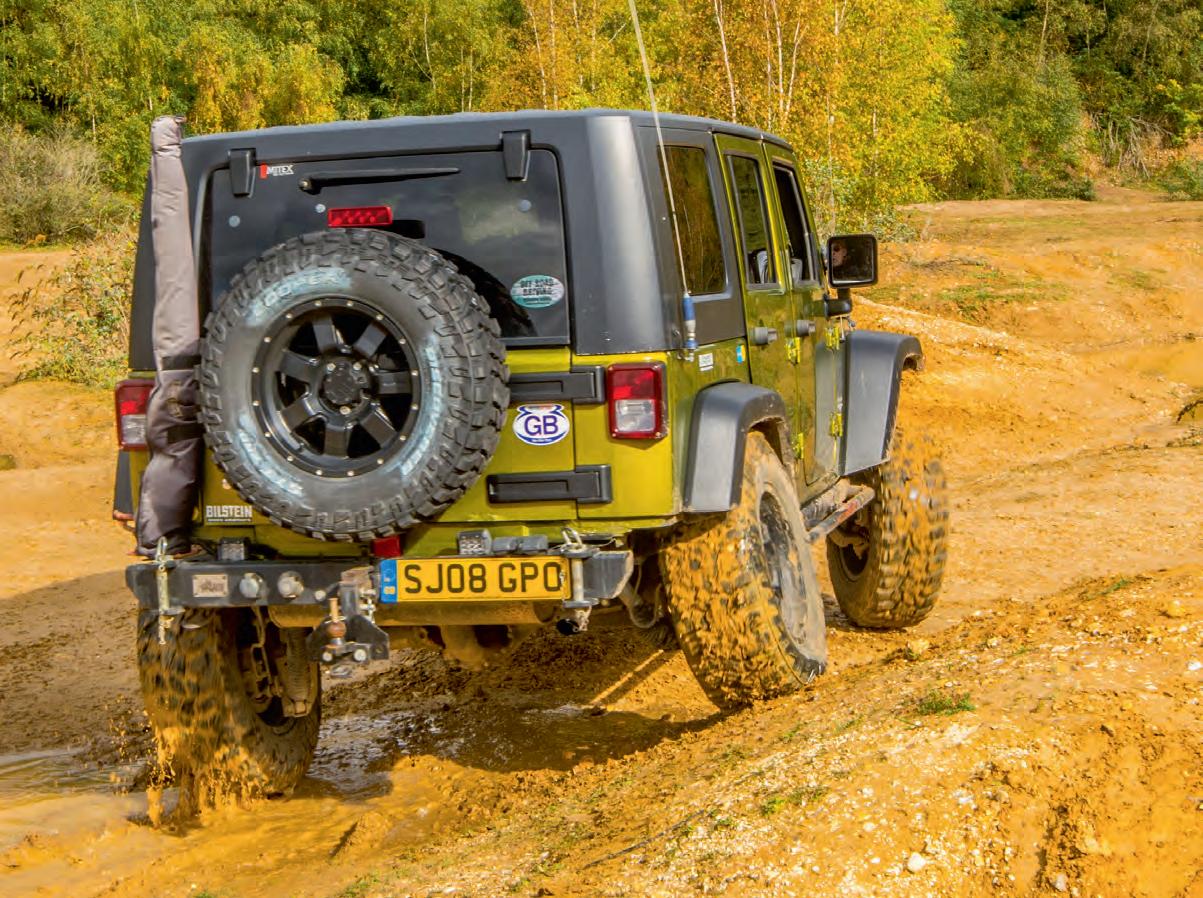
12 minute read
Pro Jeep What a leading off-road instructor does for fun on his days off

LIVING THE DREAM





John Morgan is one of Britain’s best known off-road driving instructors. And when he’s not off-roading for a living, he likes nothing more than… to go off-roading. He’s living the dream, you might say – and when you see the Jeep Wrangler he’s doing it in, you may well conclude that he’s driving the dream, too


Words: Paul Looe Pictures: Harry Hamm
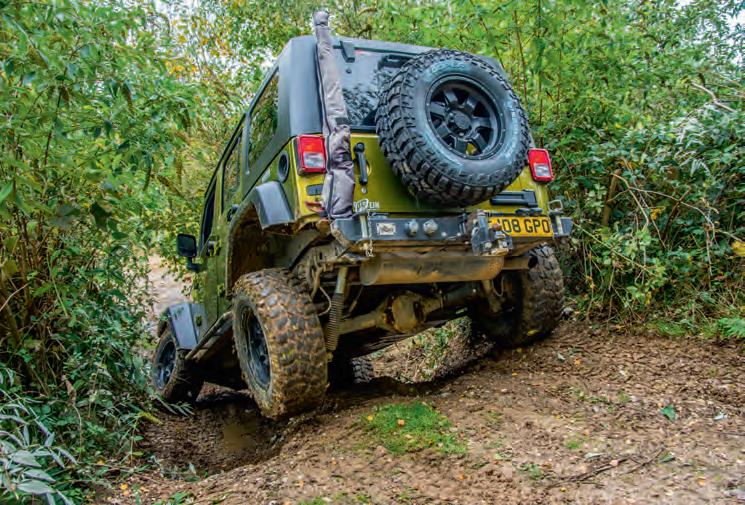
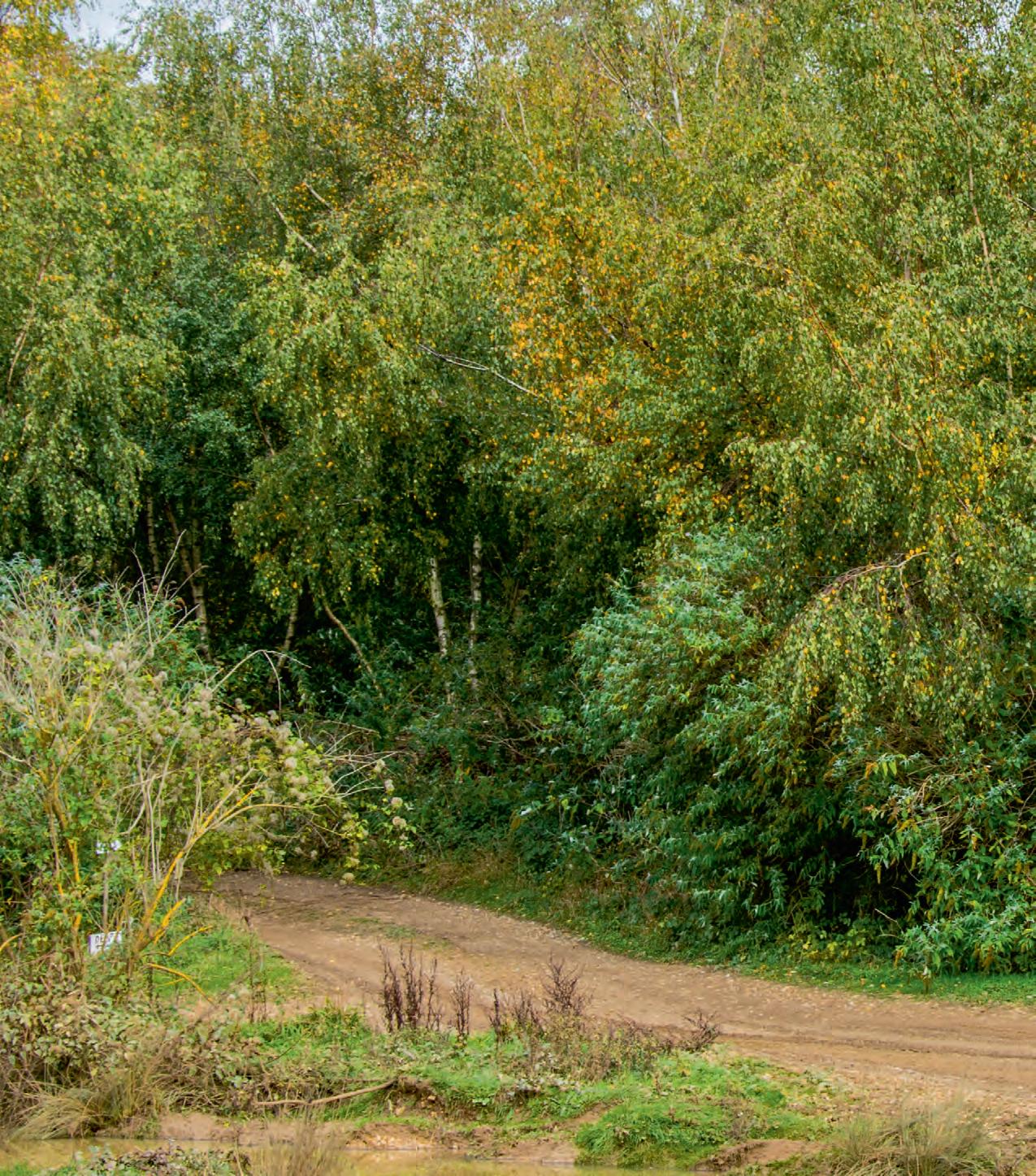
John Morgan is a well known fi gure in the off-road world. He’s one of Britain’s leading driving instructors, with a huge roster of clients from a wide variety of professional fi elds, and he’s also the man behind Slindon Safari – a long-running and incredibly popular playday site near Chichester which opens its doors twice a month.

But he’s more than just an off-road pro. He’s a man who, you might say, is living the dream – because he makes his money by doing what is a lifelong passion.
Like most people in the off-road training game, John has had a lot to do with Land Rovers. But a decade or so years ago, he broke the habit of a lifetime and built a modifi ed Jeep Wrangler TJ as his off-road weapon for work and play. A few years after that, he did the same thing with a Toyota Hilux. And alongside the regular 4x4s, he’s had a steady stream of quad bikes which he uses for everything from marshalling on open days to going on green laning holidays in Wales.
Yes, he’s a man who does off-roading for a living, day in, day out – then when it’s time to kick back and relax, he goes off-roading for his hols. You’re a little jealous, aren’t you?
His latest chariot is perhaps the logical next step after the aforementioned TJ. About a year and a half ago, he saw a long-wheelbase JK Wrangler Unlimited advertised locally with a nice, low 55,000 miles on the clock, and a deal was duly done.



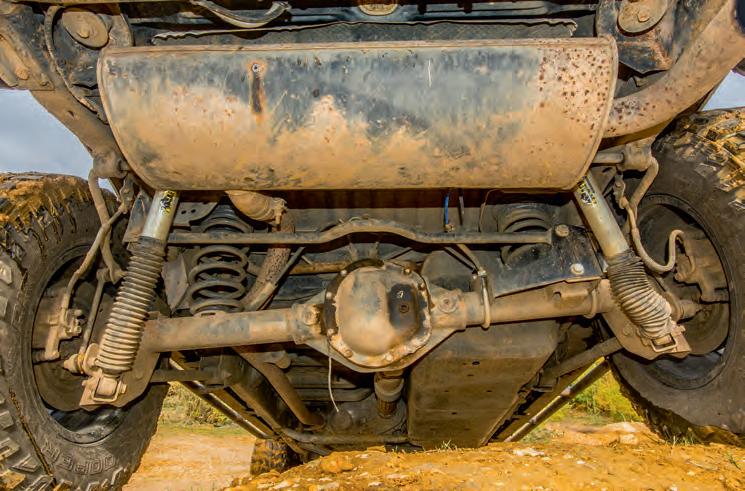
AEV’s +2” Dualsport suspension provides just enough lift and loads of travel. Note also the manual sway bar disconnects which free off the front axle to make the most of it
Being a 2008 model, it’s from pretty early on in the JK’s lifetime. This is potentially a good thing, though, because those early ones were plated to tow trailers weighing up to 3500kg – a fi gure which collapsed through the fl oor when the fi rst round of revisions were made to the vehicle after just two or three model years.
John’s JK does have a tow hitch, and sure enough it’s often to be seen with a trailer behind it. But it was built primarily for off-roading – and whether it’s hitting the lanes, venturing over the Channel to take on the big hills of Marquenterre or just making the most of having the run of Slindon seven days a week, that’s what it’s best at.
You’d say that about any Wrangler, of course, let alone a modifi ed one. Though this example is a Sahara model, rather than the higher-spec Rubicon which Jeep introduced to Britain when the JK was new. With its own list of off-road accessories as standard, the Rubicon is often called the world’s best turn-key off-roader – but John’s proves that any Wrangler is going to put on a strong showing in the sort of terrain that makes lesser 4x4s cry.
‘I’m not fi tting lockers,’ he says. ‘The traction control is excellent and enables the Jeep to climb up my test track at Slindon, through cross-axle holes three to four feet deep, with the front sway bar disconnected.
‘This track is signposted “Tech One” after a very severe test track I drove recently at a military off-road site in North Devon.’ We watched as John demonstrated the truck’s abilities over this and other extremely uneven bits of ground, and he’s right – it rarely needed anything more than just a blip on the loud pedal to coax it over the extreme, wheel-waving axle-twisters.
So it’s more than capable in standard form, as you’d expect of a Wrangler. And that means this one is more than more than capable, because John has added +2” AEV Dualsport long-travel suspension, manual front sway bar disconnects and a set of 285/70R17 Cooper Discoverer STT Pro mud-terrains.
That’s just under 33” in height – nowhere near as big as you can fi nd on Wranglers, but enough to get the job done. ‘I would have liked 35” tyres,’ John admits. ‘But that would have required more lift – as well as changing the ring and pinions. I haven’t had to re-gear it, so the tyre size is okay with the standard diff ratios.’
Something he did have to do when he bought the Jeep was replace its clutch, which was slipping in high gears. The timing belt and water pump were done, too, which is just good sense.
Remapping the engine may or may not count as good sense, depending on what you opinion is of these things. John’s Wrangler is warmed up by a Stage One job, which he installed along with a Sprint Booster.
This is a high-tech box of tricks for vehicles with drive-by-wire accelerators. It converts the digital signal from the Electronic Throttle Control unit and basically translates it into a ‘go faster’ message to the engine’s Control Module. Winner of the Global Media Award at SEMA in 2016, its


Below left: 285/70R17 Cooper Discoverer STT Pros stand just under 33” tall and give the Jeep a taller stance, and loads of traction, without messing too much with its overall gearing. They’re mounted on Type M14 heavy-duty alloys wheels from Mamba Below right: The tyres aren’t huge, at least not by Wrangler standards. All the same, they’re big enough to warrant a heavy-duty steering damper from Old Man Emu

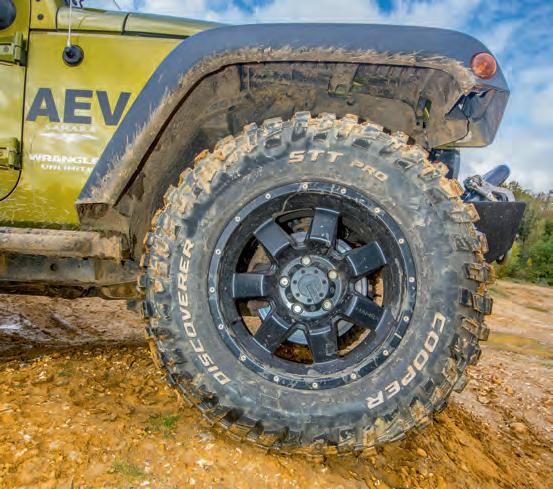


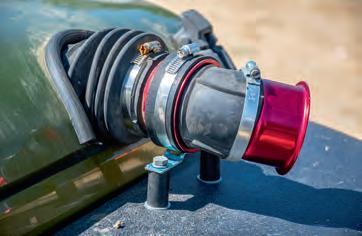
Above left: Jeep’s 2.8 CRD diesel engine is a solid performer, and it helped take the Wrangler to the masses when the JK was new. Aside from a few extra battery cables for the winch, it looks pretty standard here – though a Stage One remap and adjustable Sprint Booster means the vehicle has much more get-up-and-go than standard Above right: The engine breathes through a home-made snorkel. All too often, such things are made from plastic guttering and look obscenely bad, but this is the business. John only raised the engine’s air intake by ten inches, on the basis that ‘I don’t intend going any deeper.’ It’s positioned just above bonnet, so as to allow better judgement of a safe depth from the driver’s seat

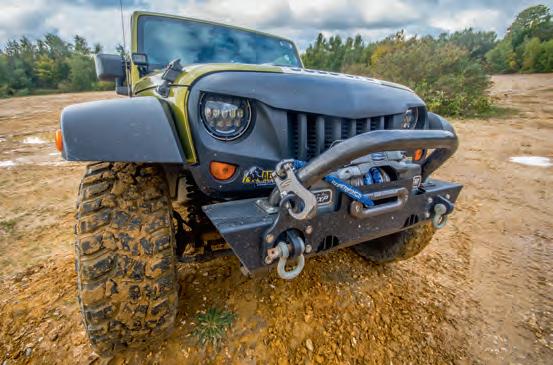
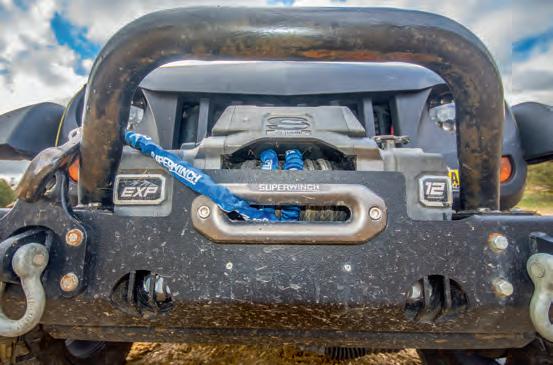
Above: A stubby front bumper from Rugged Ridge is home to a Superwinch EXP 12 wound with Dyneema rope Below left: The rear bumper is a home-made affair complete with recovery points, LED reversing lights, twin towing electric outputs and a receiver hitch for the drop plate you see here. This is an early Wrangler JKU, from the days when the long-wheelbase model was still plated to haul 3500kg Below right: If you’ve ever had a Suzuki 4x4, of you do your off-roading anywhere along the south coast, you’ll have heard of Rhino Ray. The man’s a bit of a legend, and he doesn’t just work on Suzukis – as these fabricated rock sliders on John’s Wrangler demonstrate
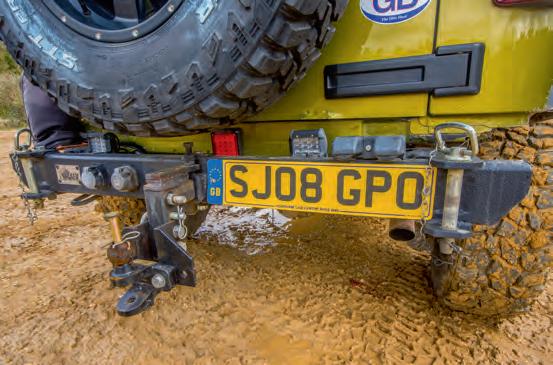

purpose is to cut out the throttle lag you get on so many modern vehicles.
‘It increases the voltage to the ECU for much better acceleration and speed off the line,’ explains John. ‘It totally transformed the performance. Without it, I found a slight lag on the pedal, especially when starting off.
‘You can adjust it from 0-9 with a button on a flying lead. I leave mine at 9 on the road, but off-road it’s best in the range from 0-3. If you set at 9 off-road, you get a power surge at about 3000rpm which, when hill climbing, makes you airborne at the top. Not really what you want!’
Fitting a Sprint Booster involves connecting it in between the vehicle’s pedal and the position sensor which determines the signal sent to the throttle. ‘It’s a bit of a pig,’ says John, ‘as the module plugs into the top of the accelerator pedal support and you then have to insert the plug for the flying lead one-handed into the existing socket, which is now also on a flying lead. ‘If you were a contortionist, it would be easy!’ Further modifications fitted to the vehicle included an Old Man Emu heavy-duty steering damper, a Superwinch EXP 12 winch on a heavy-duty Rugged Ridge bumper and a home-made snorkel. Unusually, this raises the original intake by ten inches. ‘It’s just above the bonnet,’ explains John, ‘to enable better judgement of safe depth. I don’t intend going any deeper than that!’
If you know Slindon, you’ll be aware that going a lot deeper than that is something you can do very easily indeed. Fortunately, John really knows Slindon, so he’s able to steer clear of the very gnarliest bits.
Something else John made at home was a rear recovery bumper. This is fitted with a receiver hitch and twin trailer sockets for when he’s taking advantage of that 3500kg plate weight. In between the bumpers are a pair of custom rock sliders, which were fabricated by Rhino Ray – who’s known mainly as a Suzuki specialist, but is also just a general legend in off-road circles down Sussex way.
The Jeep also has a lot of LED lights. Which is the best kind of LED lights to have, obviously. The list includes headlamp replacement units, twin reversing lights and high-level spots mounted at the base of the A-posts. The A-posts are also home to a set of brackets for the door mirrors – so that when the sun is out, the mood’s jaunty and the doors come off the way only a Jeep’s can, the mirrors don’t go with them.
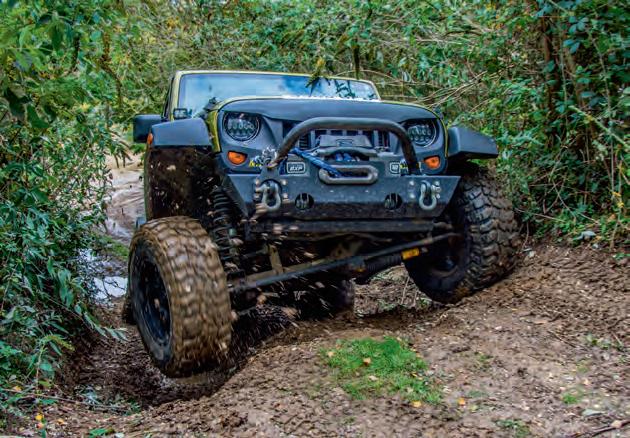
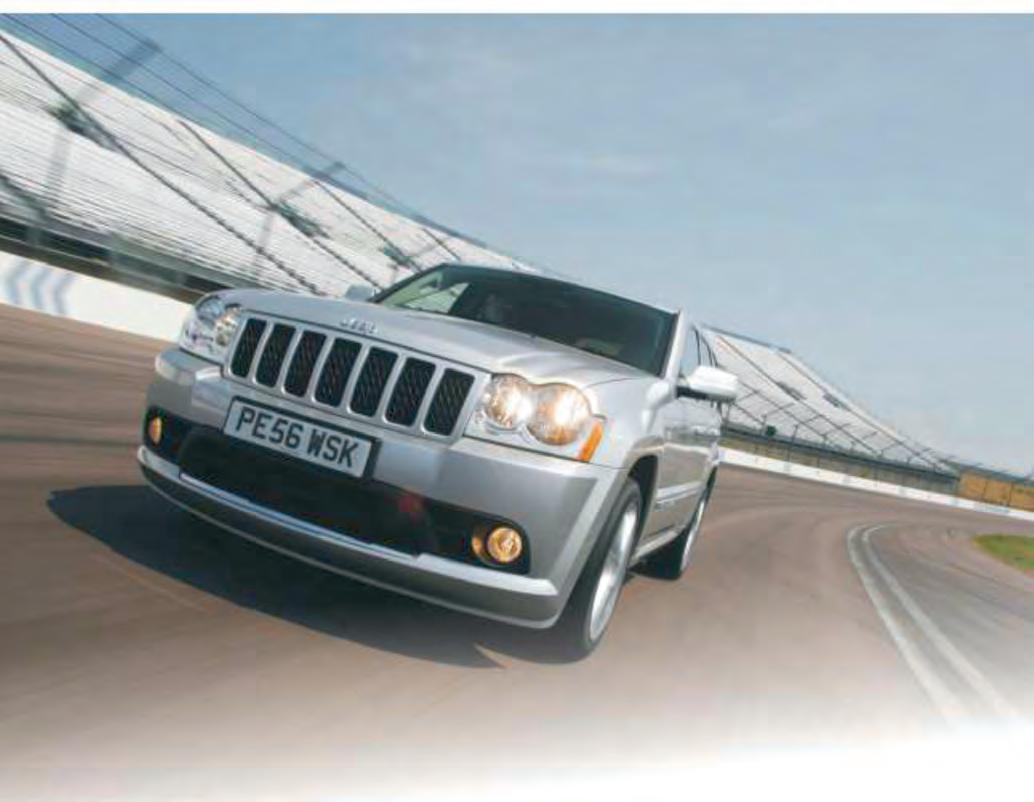


Above left: There’s LEDs everywhere to be found on this truck. The headlamps have been replaced by a set, there’s a pair used as reversing lights at the back and here, a couple of brackets turn the base of the A-pillars into a handy home for these high-level spots Above right: There are a few things to notice in the cabin. One is that the fabric seats have been replaced with leather ones from a Rubicon. Another is that the carpets have disappeared, as the leaky roof panels can’t get them saturated if they’re not there any more. You can’t see, but there’s a CB in the box between the front seats – and a Pioneer DAB head unit has been installed to operate through the standard amp and speakers
Talking of removing things, the JK Wrangler was famous for its lift-out roof panels. Which in turn makes them famous for something else, especially when you introduce the joys of British weather.
‘When you find six rubber drain plugs under the carpet in the footwells, that should tell you something!’ says John. ‘Mine now has no carpet, so it dries out quickly.
‘Apparently all these JKs leak from the roof panels above the drivers and front-seat passenger’s heads. So, fed up with two inches of water in all four footwells, I silicone them for the winter.’ The cloth front seats have been replaced with leather ones from a Rubicon, too, which makes them that bit more waterproof.
These are the small details that turn a great 4x4 into your great 4x4. Major modifications like the suspension are at the heart of any build, of course – but the personal touches are every bit as important when all’s said and done.
And it’s all come together exactly as John planned to make this the latest, and possibly the best, in a long line of trucks that he’s owned. ‘I’m very pleased with the JK,’ he confirms. ‘It has a fast cruising speed on the road and is capable and comfortable off-road.’
And on top of that, it’s the perfect work truck… and the perfect toy. Whether it’s managing a playday at Slindon, laning in Wales or crossing the Channel en route to Marquenterre, John Morgan is a man with the wheels for the job. If you didn’t already think he was living the dream, you should be now.
